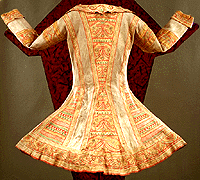
Naskapi Man's Coat
 |
Collected by General Sir Gordon Drummond, 1813-1816. Tanned caribou skin, pigments of vermilion and washing blue, fish roe; 103 cm. long The man who wore this painted caribou-skin coat may have done so to propitiate and honour the spirit of the caribou he sought to kill. He was a Naskapi Indian, whose people lived in northeastern Quebec and Labrador. They were semi-nomadic hunters, dependent particularly on caribou for food and for the raw materials needed to make clothing, tools and weapons. This summer coat is an unusually fine example of the Naskapi decorative tradition. Its elaborate designs were probably painted with imported pigments and with fish roe, which yellows with age. Before the arrival of Europeans, paints were made from plants and from natural deposits of red and yellow ochre. Such coats became popular trade items. |
 |
Naskapi painting sticks; collected in Labrador by Duncan Burgess in 1930, Richard White Jr. in 1930, and Alika Podolinsky in 1961. Caribou antler, bone, wood; lengths range from 7 cm. to 17.2 cm. The woman who painted this coat of soft white caribou skins would have used tools like the ones pictured here. Those with two or more tines were for drawing parallel lines; others, with a flattened semicircular end, produced curves. |
